HLTENN012 Assignment: Implementing Care for Chronic Conditions
VerifiedAdded on 2023/06/03
|13
|2224
|244
Homework Assignment
AI Summary
This assignment focuses on implementing and monitoring care for individuals with chronic health problems, referencing Australian healthcare contexts and specific conditions. It addresses various aspects of chronic disease management, including cancer development sites in Australia, tracheostomy procedures, and clinical manifestations of conditions like asthma, COPD, chronic pain, renal failure, heart failure, diabetes, eczema, incontinence, motor neuron disease, epilepsy, coma, osteoarthritis, Parkinson’s disease, rheumatoid arthritis, cerebrovascular accident (CVA), and systemic lupus erythematosus (SLE). The assignment further explores the impact of type 2 diabetes mellitus (2DM) on individuals and their families, covering lifestyle changes, emotional symptoms, physical damage, psychological disorders, and economic costs. It also discusses strategies for managing diabetes risks, the role of person-centered nurses, medications for type 2 diabetes, community programs for diabetes prevention, and the importance of documentation in healthcare. The role of ancillary teams (pharmacists, dietitians, psychologists) and various rehabilitation strategies (physiotherapy, occupational therapy, hydrotherapy, Pilates, massage, art/music therapy) are highlighted. Finally, the assignment touches on the National Disability Insurance Scheme (NDIS), the National Strategic Framework for Chronic Conditions, and the Continuum of Care, emphasizing the prevalence and management of chronic diseases in Australia.

Running head: CHRONIC DISEASES 1
Care for People with Chronic Diseases
Name
Institution
Course
Professor
Date
Care for People with Chronic Diseases
Name
Institution
Course
Professor
Date
Paraphrase This Document
Need a fresh take? Get an instant paraphrase of this document with our AI Paraphraser
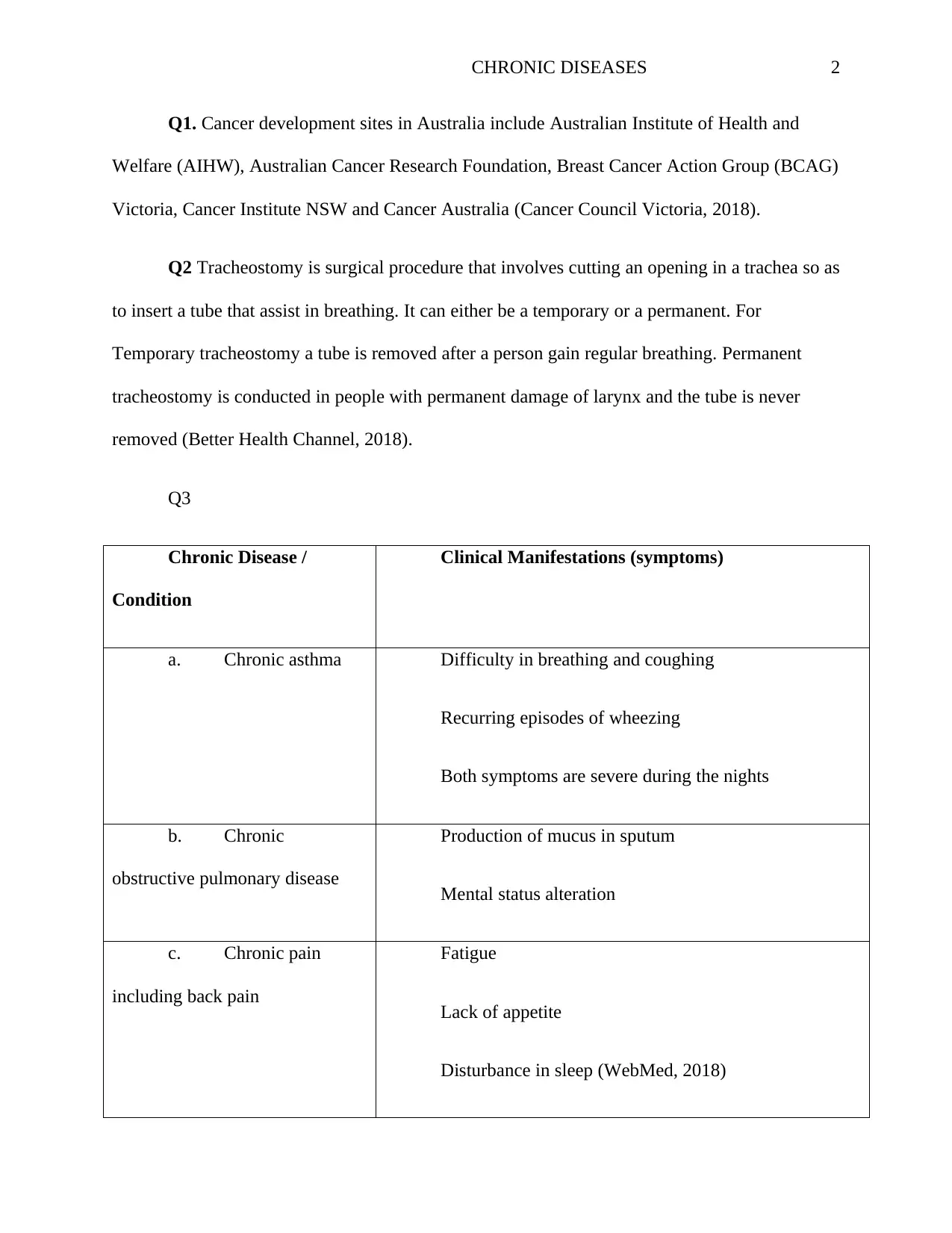
CHRONIC DISEASES 2
Q1. Cancer development sites in Australia include Australian Institute of Health and
Welfare (AIHW), Australian Cancer Research Foundation, Breast Cancer Action Group (BCAG)
Victoria, Cancer Institute NSW and Cancer Australia (Cancer Council Victoria, 2018).
Q2 Tracheostomy is surgical procedure that involves cutting an opening in a trachea so as
to insert a tube that assist in breathing. It can either be a temporary or a permanent. For
Temporary tracheostomy a tube is removed after a person gain regular breathing. Permanent
tracheostomy is conducted in people with permanent damage of larynx and the tube is never
removed (Better Health Channel, 2018).
Q3
Chronic Disease /
Condition
Clinical Manifestations (symptoms)
a. Chronic asthma Difficulty in breathing and coughing
Recurring episodes of wheezing
Both symptoms are severe during the nights
b. Chronic
obstructive pulmonary disease
Production of mucus in sputum
Mental status alteration
c. Chronic pain
including back pain
Fatigue
Lack of appetite
Disturbance in sleep (WebMed, 2018)
Q1. Cancer development sites in Australia include Australian Institute of Health and
Welfare (AIHW), Australian Cancer Research Foundation, Breast Cancer Action Group (BCAG)
Victoria, Cancer Institute NSW and Cancer Australia (Cancer Council Victoria, 2018).
Q2 Tracheostomy is surgical procedure that involves cutting an opening in a trachea so as
to insert a tube that assist in breathing. It can either be a temporary or a permanent. For
Temporary tracheostomy a tube is removed after a person gain regular breathing. Permanent
tracheostomy is conducted in people with permanent damage of larynx and the tube is never
removed (Better Health Channel, 2018).
Q3
Chronic Disease /
Condition
Clinical Manifestations (symptoms)
a. Chronic asthma Difficulty in breathing and coughing
Recurring episodes of wheezing
Both symptoms are severe during the nights
b. Chronic
obstructive pulmonary disease
Production of mucus in sputum
Mental status alteration
c. Chronic pain
including back pain
Fatigue
Lack of appetite
Disturbance in sleep (WebMed, 2018)
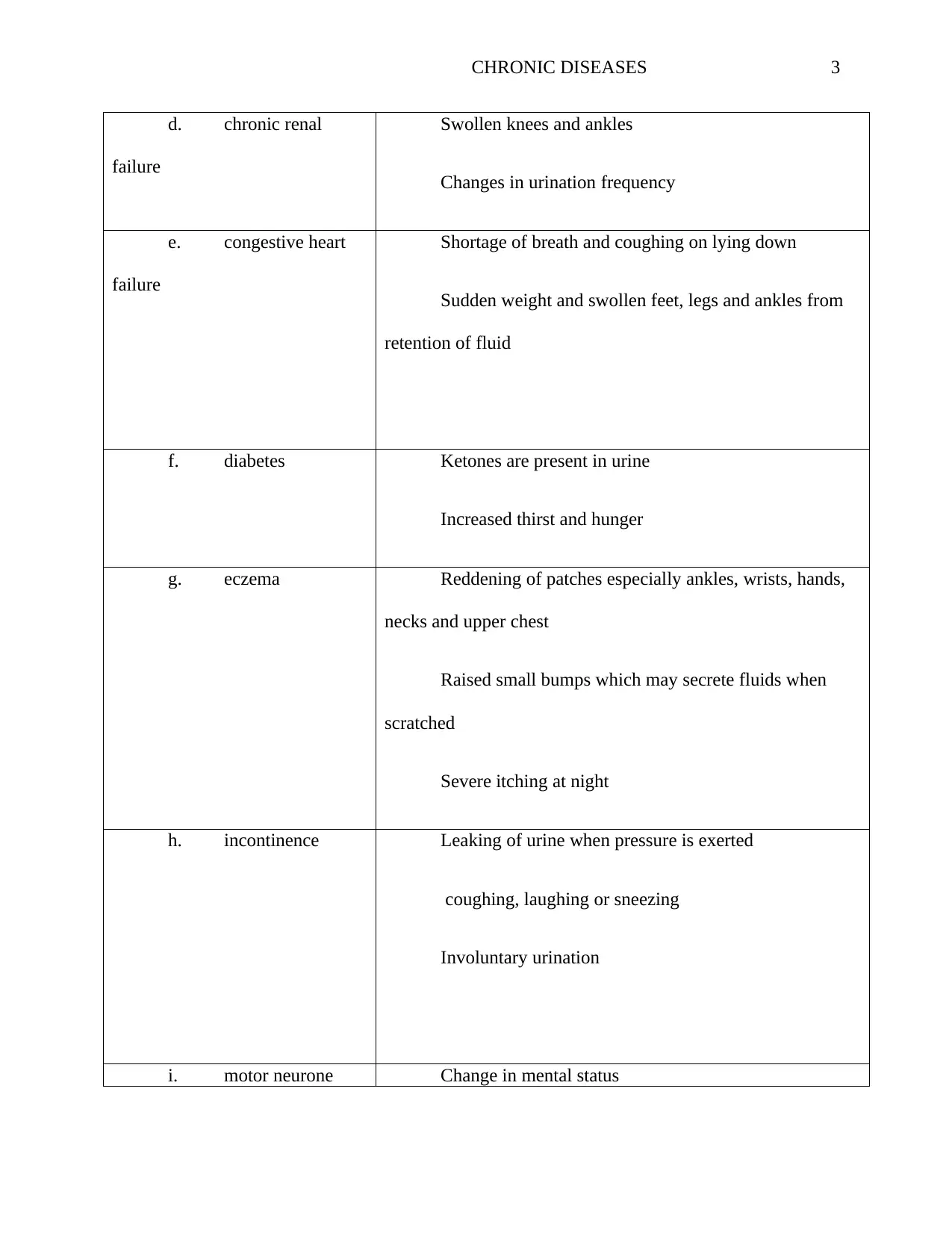
CHRONIC DISEASES 3
d. chronic renal
failure
Swollen knees and ankles
Changes in urination frequency
e. congestive heart
failure
Shortage of breath and coughing on lying down
Sudden weight and swollen feet, legs and ankles from
retention of fluid
f. diabetes Ketones are present in urine
Increased thirst and hunger
g. eczema Reddening of patches especially ankles, wrists, hands,
necks and upper chest
Raised small bumps which may secrete fluids when
scratched
Severe itching at night
h. incontinence Leaking of urine when pressure is exerted
coughing, laughing or sneezing
Involuntary urination
i. motor neurone Change in mental status
d. chronic renal
failure
Swollen knees and ankles
Changes in urination frequency
e. congestive heart
failure
Shortage of breath and coughing on lying down
Sudden weight and swollen feet, legs and ankles from
retention of fluid
f. diabetes Ketones are present in urine
Increased thirst and hunger
g. eczema Reddening of patches especially ankles, wrists, hands,
necks and upper chest
Raised small bumps which may secrete fluids when
scratched
Severe itching at night
h. incontinence Leaking of urine when pressure is exerted
coughing, laughing or sneezing
Involuntary urination
i. motor neurone Change in mental status
⊘ This is a preview!⊘
Do you want full access?
Subscribe today to unlock all pages.

Trusted by 1+ million students worldwide
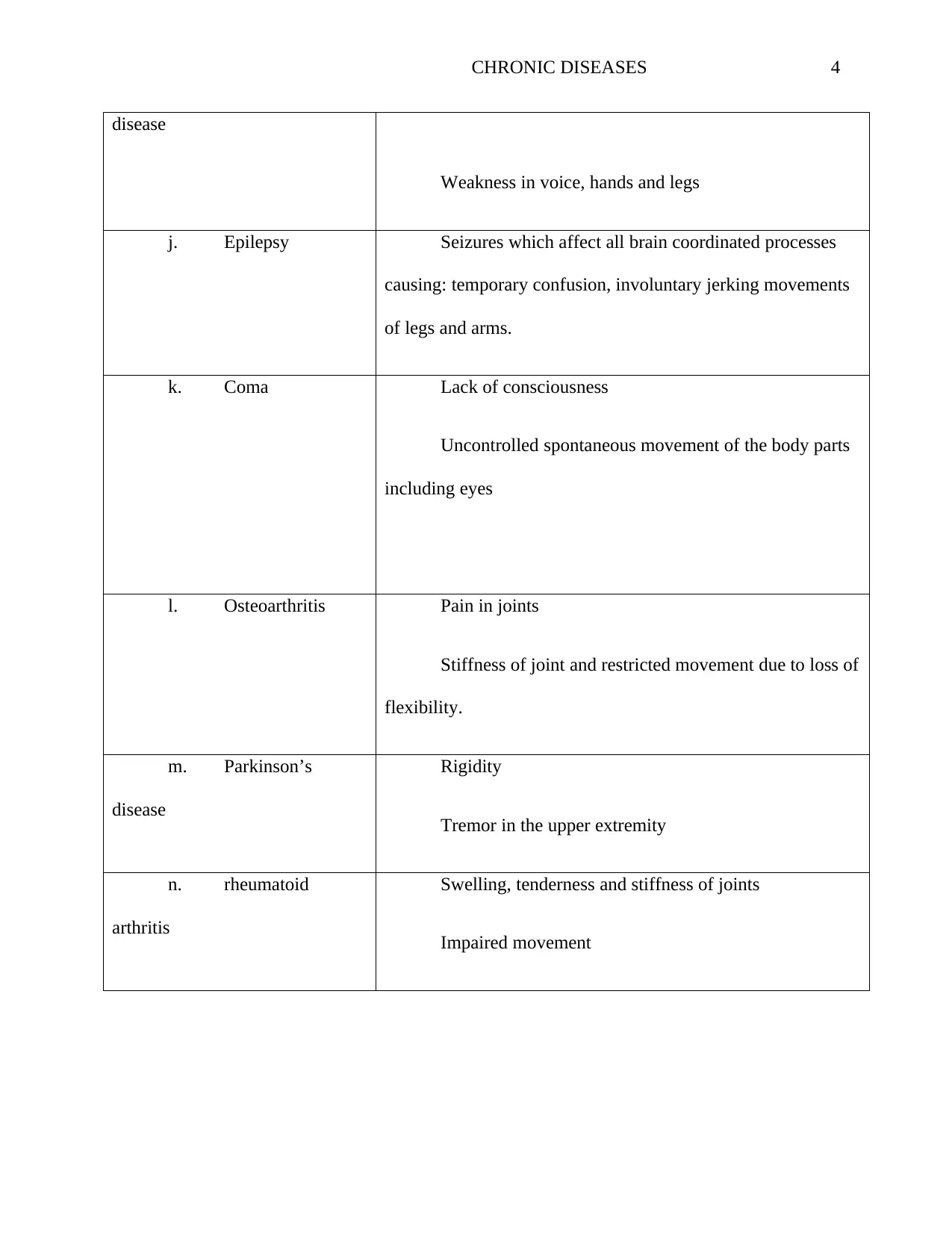
CHRONIC DISEASES 4
disease
Weakness in voice, hands and legs
j. Epilepsy Seizures which affect all brain coordinated processes
causing: temporary confusion, involuntary jerking movements
of legs and arms.
k. Coma Lack of consciousness
Uncontrolled spontaneous movement of the body parts
including eyes
l. Osteoarthritis Pain in joints
Stiffness of joint and restricted movement due to loss of
flexibility.
m. Parkinson’s
disease
Rigidity
Tremor in the upper extremity
n. rheumatoid
arthritis
Swelling, tenderness and stiffness of joints
Impaired movement
disease
Weakness in voice, hands and legs
j. Epilepsy Seizures which affect all brain coordinated processes
causing: temporary confusion, involuntary jerking movements
of legs and arms.
k. Coma Lack of consciousness
Uncontrolled spontaneous movement of the body parts
including eyes
l. Osteoarthritis Pain in joints
Stiffness of joint and restricted movement due to loss of
flexibility.
m. Parkinson’s
disease
Rigidity
Tremor in the upper extremity
n. rheumatoid
arthritis
Swelling, tenderness and stiffness of joints
Impaired movement
Paraphrase This Document
Need a fresh take? Get an instant paraphrase of this document with our AI Paraphraser
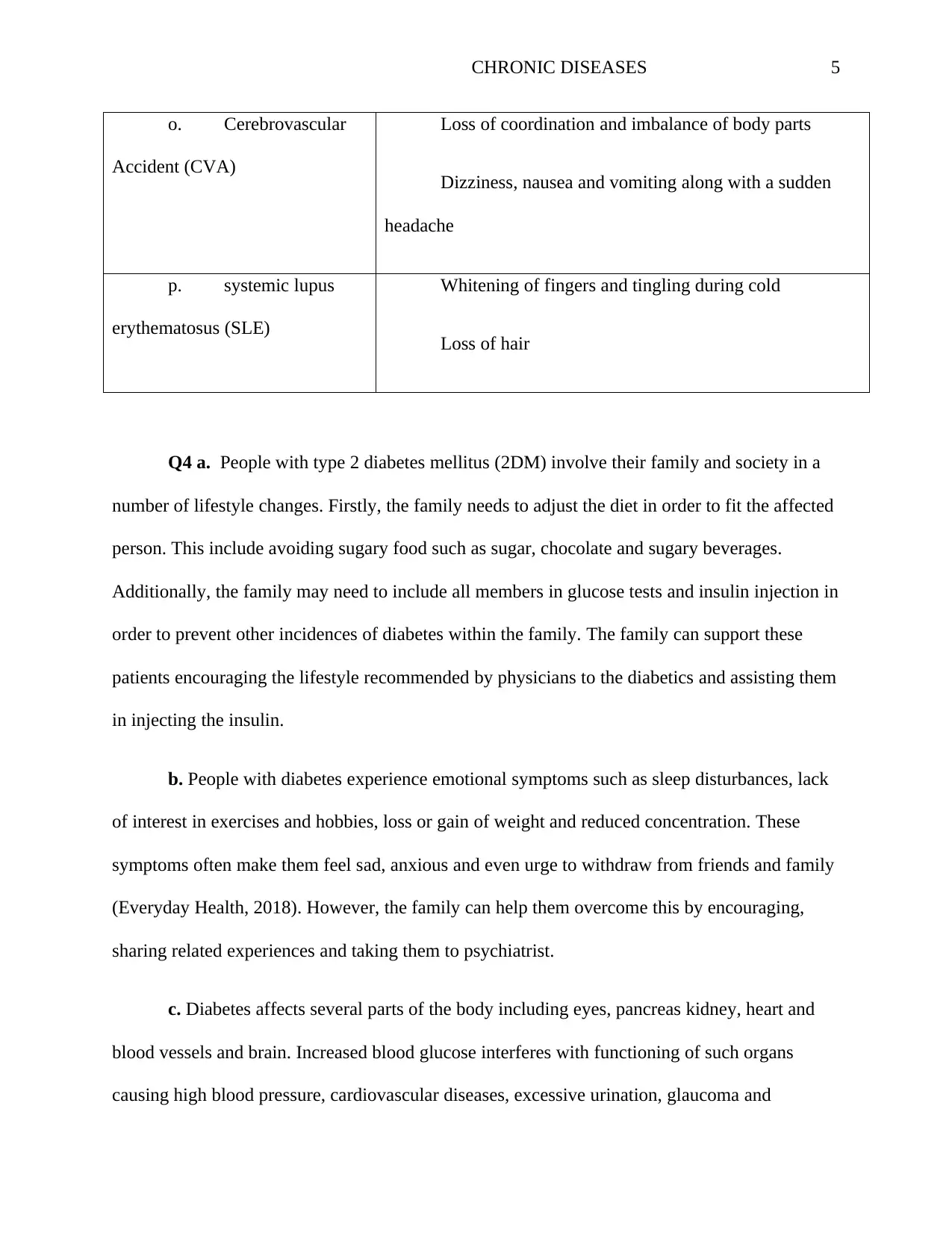
CHRONIC DISEASES 5
o. Cerebrovascular
Accident (CVA)
Loss of coordination and imbalance of body parts
Dizziness, nausea and vomiting along with a sudden
headache
p. systemic lupus
erythematosus (SLE)
Whitening of fingers and tingling during cold
Loss of hair
Q4 a. People with type 2 diabetes mellitus (2DM) involve their family and society in a
number of lifestyle changes. Firstly, the family needs to adjust the diet in order to fit the affected
person. This include avoiding sugary food such as sugar, chocolate and sugary beverages.
Additionally, the family may need to include all members in glucose tests and insulin injection in
order to prevent other incidences of diabetes within the family. The family can support these
patients encouraging the lifestyle recommended by physicians to the diabetics and assisting them
in injecting the insulin.
b. People with diabetes experience emotional symptoms such as sleep disturbances, lack
of interest in exercises and hobbies, loss or gain of weight and reduced concentration. These
symptoms often make them feel sad, anxious and even urge to withdraw from friends and family
(Everyday Health, 2018). However, the family can help them overcome this by encouraging,
sharing related experiences and taking them to psychiatrist.
c. Diabetes affects several parts of the body including eyes, pancreas kidney, heart and
blood vessels and brain. Increased blood glucose interferes with functioning of such organs
causing high blood pressure, cardiovascular diseases, excessive urination, glaucoma and
o. Cerebrovascular
Accident (CVA)
Loss of coordination and imbalance of body parts
Dizziness, nausea and vomiting along with a sudden
headache
p. systemic lupus
erythematosus (SLE)
Whitening of fingers and tingling during cold
Loss of hair
Q4 a. People with type 2 diabetes mellitus (2DM) involve their family and society in a
number of lifestyle changes. Firstly, the family needs to adjust the diet in order to fit the affected
person. This include avoiding sugary food such as sugar, chocolate and sugary beverages.
Additionally, the family may need to include all members in glucose tests and insulin injection in
order to prevent other incidences of diabetes within the family. The family can support these
patients encouraging the lifestyle recommended by physicians to the diabetics and assisting them
in injecting the insulin.
b. People with diabetes experience emotional symptoms such as sleep disturbances, lack
of interest in exercises and hobbies, loss or gain of weight and reduced concentration. These
symptoms often make them feel sad, anxious and even urge to withdraw from friends and family
(Everyday Health, 2018). However, the family can help them overcome this by encouraging,
sharing related experiences and taking them to psychiatrist.
c. Diabetes affects several parts of the body including eyes, pancreas kidney, heart and
blood vessels and brain. Increased blood glucose interferes with functioning of such organs
causing high blood pressure, cardiovascular diseases, excessive urination, glaucoma and
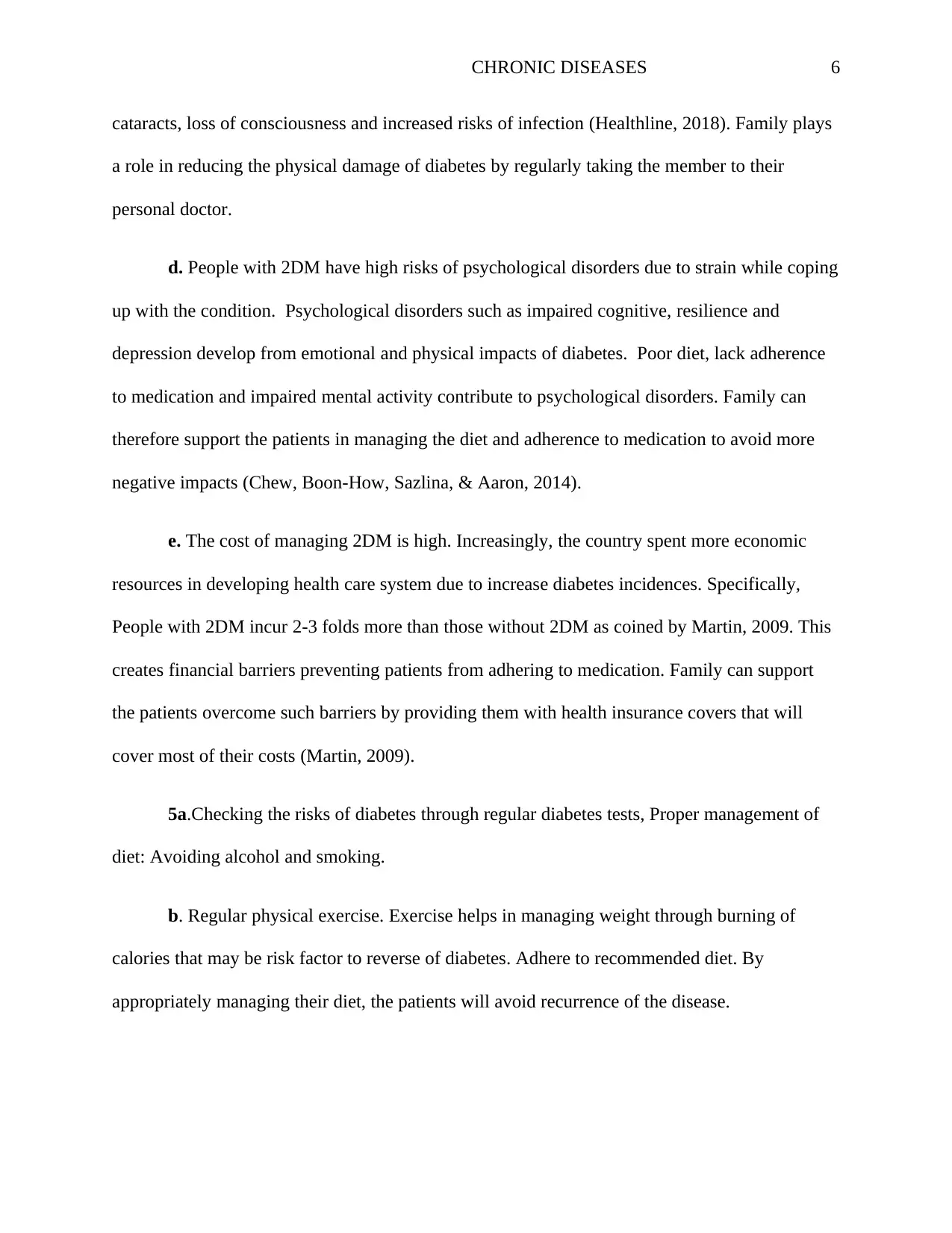
CHRONIC DISEASES 6
cataracts, loss of consciousness and increased risks of infection (Healthline, 2018). Family plays
a role in reducing the physical damage of diabetes by regularly taking the member to their
personal doctor.
d. People with 2DM have high risks of psychological disorders due to strain while coping
up with the condition. Psychological disorders such as impaired cognitive, resilience and
depression develop from emotional and physical impacts of diabetes. Poor diet, lack adherence
to medication and impaired mental activity contribute to psychological disorders. Family can
therefore support the patients in managing the diet and adherence to medication to avoid more
negative impacts (Chew, Boon-How, Sazlina, & Aaron, 2014).
e. The cost of managing 2DM is high. Increasingly, the country spent more economic
resources in developing health care system due to increase diabetes incidences. Specifically,
People with 2DM incur 2-3 folds more than those without 2DM as coined by Martin, 2009. This
creates financial barriers preventing patients from adhering to medication. Family can support
the patients overcome such barriers by providing them with health insurance covers that will
cover most of their costs (Martin, 2009).
5a.Checking the risks of diabetes through regular diabetes tests, Proper management of
diet: Avoiding alcohol and smoking.
b. Regular physical exercise. Exercise helps in managing weight through burning of
calories that may be risk factor to reverse of diabetes. Adhere to recommended diet. By
appropriately managing their diet, the patients will avoid recurrence of the disease.
cataracts, loss of consciousness and increased risks of infection (Healthline, 2018). Family plays
a role in reducing the physical damage of diabetes by regularly taking the member to their
personal doctor.
d. People with 2DM have high risks of psychological disorders due to strain while coping
up with the condition. Psychological disorders such as impaired cognitive, resilience and
depression develop from emotional and physical impacts of diabetes. Poor diet, lack adherence
to medication and impaired mental activity contribute to psychological disorders. Family can
therefore support the patients in managing the diet and adherence to medication to avoid more
negative impacts (Chew, Boon-How, Sazlina, & Aaron, 2014).
e. The cost of managing 2DM is high. Increasingly, the country spent more economic
resources in developing health care system due to increase diabetes incidences. Specifically,
People with 2DM incur 2-3 folds more than those without 2DM as coined by Martin, 2009. This
creates financial barriers preventing patients from adhering to medication. Family can support
the patients overcome such barriers by providing them with health insurance covers that will
cover most of their costs (Martin, 2009).
5a.Checking the risks of diabetes through regular diabetes tests, Proper management of
diet: Avoiding alcohol and smoking.
b. Regular physical exercise. Exercise helps in managing weight through burning of
calories that may be risk factor to reverse of diabetes. Adhere to recommended diet. By
appropriately managing their diet, the patients will avoid recurrence of the disease.
⊘ This is a preview!⊘
Do you want full access?
Subscribe today to unlock all pages.

Trusted by 1+ million students worldwide
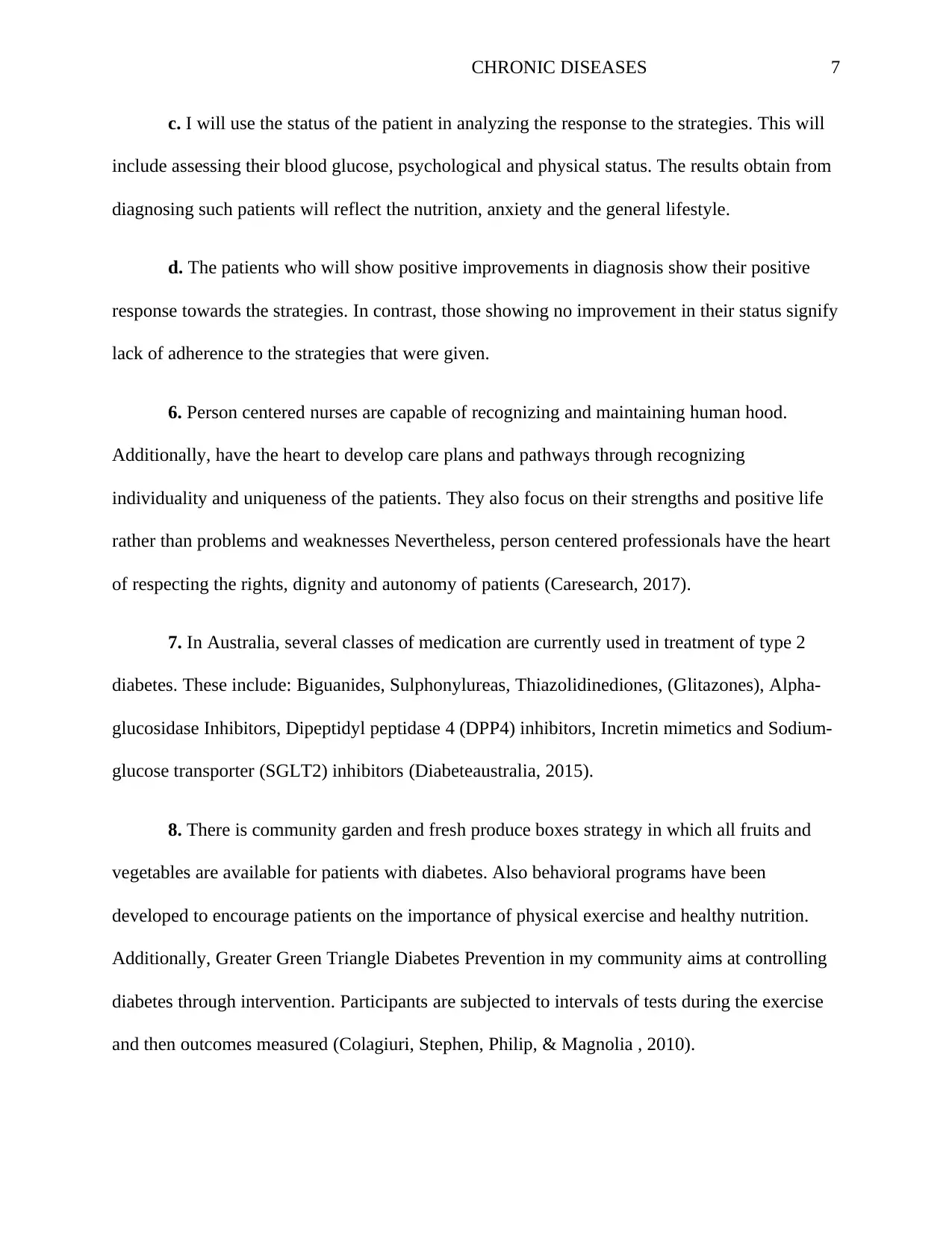
CHRONIC DISEASES 7
c. I will use the status of the patient in analyzing the response to the strategies. This will
include assessing their blood glucose, psychological and physical status. The results obtain from
diagnosing such patients will reflect the nutrition, anxiety and the general lifestyle.
d. The patients who will show positive improvements in diagnosis show their positive
response towards the strategies. In contrast, those showing no improvement in their status signify
lack of adherence to the strategies that were given.
6. Person centered nurses are capable of recognizing and maintaining human hood.
Additionally, have the heart to develop care plans and pathways through recognizing
individuality and uniqueness of the patients. They also focus on their strengths and positive life
rather than problems and weaknesses Nevertheless, person centered professionals have the heart
of respecting the rights, dignity and autonomy of patients (Caresearch, 2017).
7. In Australia, several classes of medication are currently used in treatment of type 2
diabetes. These include: Biguanides, Sulphonylureas, Thiazolidinediones, (Glitazones), Alpha-
glucosidase Inhibitors, Dipeptidyl peptidase 4 (DPP4) inhibitors, Incretin mimetics and Sodium-
glucose transporter (SGLT2) inhibitors (Diabeteaustralia, 2015).
8. There is community garden and fresh produce boxes strategy in which all fruits and
vegetables are available for patients with diabetes. Also behavioral programs have been
developed to encourage patients on the importance of physical exercise and healthy nutrition.
Additionally, Greater Green Triangle Diabetes Prevention in my community aims at controlling
diabetes through intervention. Participants are subjected to intervals of tests during the exercise
and then outcomes measured (Colagiuri, Stephen, Philip, & Magnolia , 2010).
c. I will use the status of the patient in analyzing the response to the strategies. This will
include assessing their blood glucose, psychological and physical status. The results obtain from
diagnosing such patients will reflect the nutrition, anxiety and the general lifestyle.
d. The patients who will show positive improvements in diagnosis show their positive
response towards the strategies. In contrast, those showing no improvement in their status signify
lack of adherence to the strategies that were given.
6. Person centered nurses are capable of recognizing and maintaining human hood.
Additionally, have the heart to develop care plans and pathways through recognizing
individuality and uniqueness of the patients. They also focus on their strengths and positive life
rather than problems and weaknesses Nevertheless, person centered professionals have the heart
of respecting the rights, dignity and autonomy of patients (Caresearch, 2017).
7. In Australia, several classes of medication are currently used in treatment of type 2
diabetes. These include: Biguanides, Sulphonylureas, Thiazolidinediones, (Glitazones), Alpha-
glucosidase Inhibitors, Dipeptidyl peptidase 4 (DPP4) inhibitors, Incretin mimetics and Sodium-
glucose transporter (SGLT2) inhibitors (Diabeteaustralia, 2015).
8. There is community garden and fresh produce boxes strategy in which all fruits and
vegetables are available for patients with diabetes. Also behavioral programs have been
developed to encourage patients on the importance of physical exercise and healthy nutrition.
Additionally, Greater Green Triangle Diabetes Prevention in my community aims at controlling
diabetes through intervention. Participants are subjected to intervals of tests during the exercise
and then outcomes measured (Colagiuri, Stephen, Philip, & Magnolia , 2010).
Paraphrase This Document
Need a fresh take? Get an instant paraphrase of this document with our AI Paraphraser
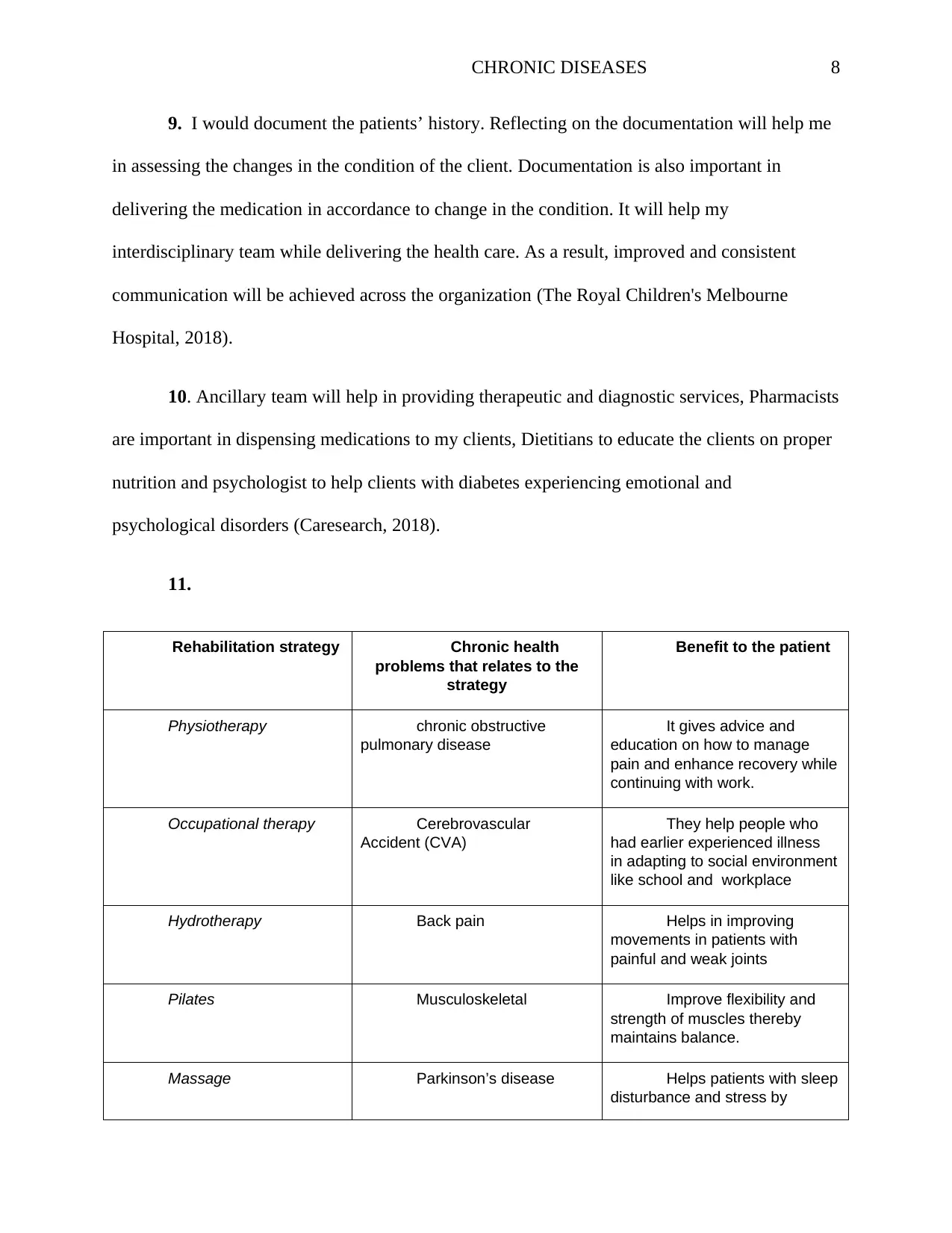
CHRONIC DISEASES 8
9. I would document the patients’ history. Reflecting on the documentation will help me
in assessing the changes in the condition of the client. Documentation is also important in
delivering the medication in accordance to change in the condition. It will help my
interdisciplinary team while delivering the health care. As a result, improved and consistent
communication will be achieved across the organization (The Royal Children's Melbourne
Hospital, 2018).
10. Ancillary team will help in providing therapeutic and diagnostic services, Pharmacists
are important in dispensing medications to my clients, Dietitians to educate the clients on proper
nutrition and psychologist to help clients with diabetes experiencing emotional and
psychological disorders (Caresearch, 2018).
11.
Rehabilitation strategy Chronic health
problems that relates to the
strategy
Benefit to the patient
Physiotherapy chronic obstructive
pulmonary disease
It gives advice and
education on how to manage
pain and enhance recovery while
continuing with work.
Occupational therapy Cerebrovascular
Accident (CVA)
They help people who
had earlier experienced illness
in adapting to social environment
like school and workplace
Hydrotherapy Back pain Helps in improving
movements in patients with
painful and weak joints
Pilates Musculoskeletal Improve flexibility and
strength of muscles thereby
maintains balance.
Massage Parkinson’s disease Helps patients with sleep
disturbance and stress by
9. I would document the patients’ history. Reflecting on the documentation will help me
in assessing the changes in the condition of the client. Documentation is also important in
delivering the medication in accordance to change in the condition. It will help my
interdisciplinary team while delivering the health care. As a result, improved and consistent
communication will be achieved across the organization (The Royal Children's Melbourne
Hospital, 2018).
10. Ancillary team will help in providing therapeutic and diagnostic services, Pharmacists
are important in dispensing medications to my clients, Dietitians to educate the clients on proper
nutrition and psychologist to help clients with diabetes experiencing emotional and
psychological disorders (Caresearch, 2018).
11.
Rehabilitation strategy Chronic health
problems that relates to the
strategy
Benefit to the patient
Physiotherapy chronic obstructive
pulmonary disease
It gives advice and
education on how to manage
pain and enhance recovery while
continuing with work.
Occupational therapy Cerebrovascular
Accident (CVA)
They help people who
had earlier experienced illness
in adapting to social environment
like school and workplace
Hydrotherapy Back pain Helps in improving
movements in patients with
painful and weak joints
Pilates Musculoskeletal Improve flexibility and
strength of muscles thereby
maintains balance.
Massage Parkinson’s disease Helps patients with sleep
disturbance and stress by
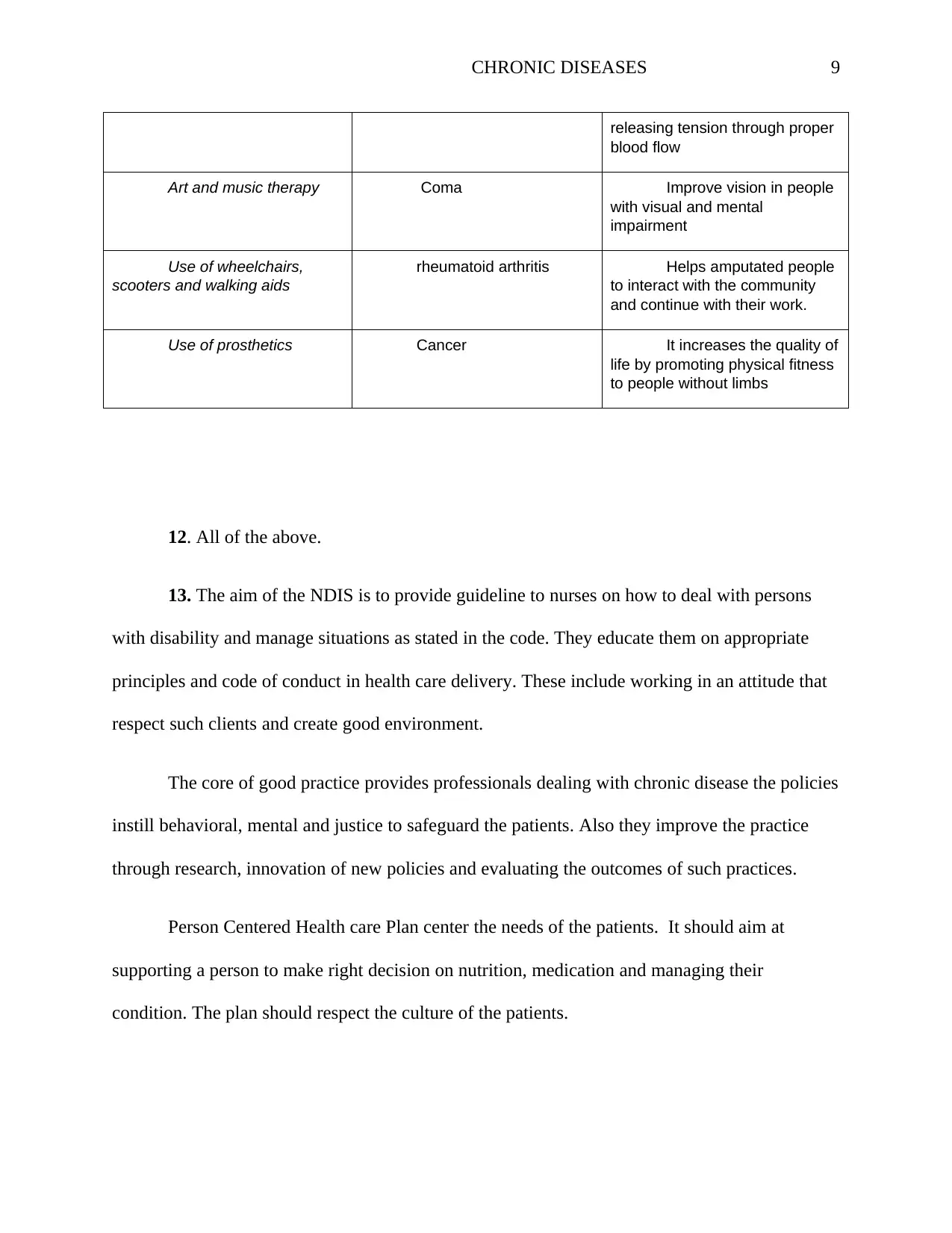
CHRONIC DISEASES 9
releasing tension through proper
blood flow
Art and music therapy Coma Improve vision in people
with visual and mental
impairment
Use of wheelchairs,
scooters and walking aids
rheumatoid arthritis Helps amputated people
to interact with the community
and continue with their work.
Use of prosthetics Cancer It increases the quality of
life by promoting physical fitness
to people without limbs
12. All of the above.
13. The aim of the NDIS is to provide guideline to nurses on how to deal with persons
with disability and manage situations as stated in the code. They educate them on appropriate
principles and code of conduct in health care delivery. These include working in an attitude that
respect such clients and create good environment.
The core of good practice provides professionals dealing with chronic disease the policies
instill behavioral, mental and justice to safeguard the patients. Also they improve the practice
through research, innovation of new policies and evaluating the outcomes of such practices.
Person Centered Health care Plan center the needs of the patients. It should aim at
supporting a person to make right decision on nutrition, medication and managing their
condition. The plan should respect the culture of the patients.
releasing tension through proper
blood flow
Art and music therapy Coma Improve vision in people
with visual and mental
impairment
Use of wheelchairs,
scooters and walking aids
rheumatoid arthritis Helps amputated people
to interact with the community
and continue with their work.
Use of prosthetics Cancer It increases the quality of
life by promoting physical fitness
to people without limbs
12. All of the above.
13. The aim of the NDIS is to provide guideline to nurses on how to deal with persons
with disability and manage situations as stated in the code. They educate them on appropriate
principles and code of conduct in health care delivery. These include working in an attitude that
respect such clients and create good environment.
The core of good practice provides professionals dealing with chronic disease the policies
instill behavioral, mental and justice to safeguard the patients. Also they improve the practice
through research, innovation of new policies and evaluating the outcomes of such practices.
Person Centered Health care Plan center the needs of the patients. It should aim at
supporting a person to make right decision on nutrition, medication and managing their
condition. The plan should respect the culture of the patients.
⊘ This is a preview!⊘
Do you want full access?
Subscribe today to unlock all pages.

Trusted by 1+ million students worldwide
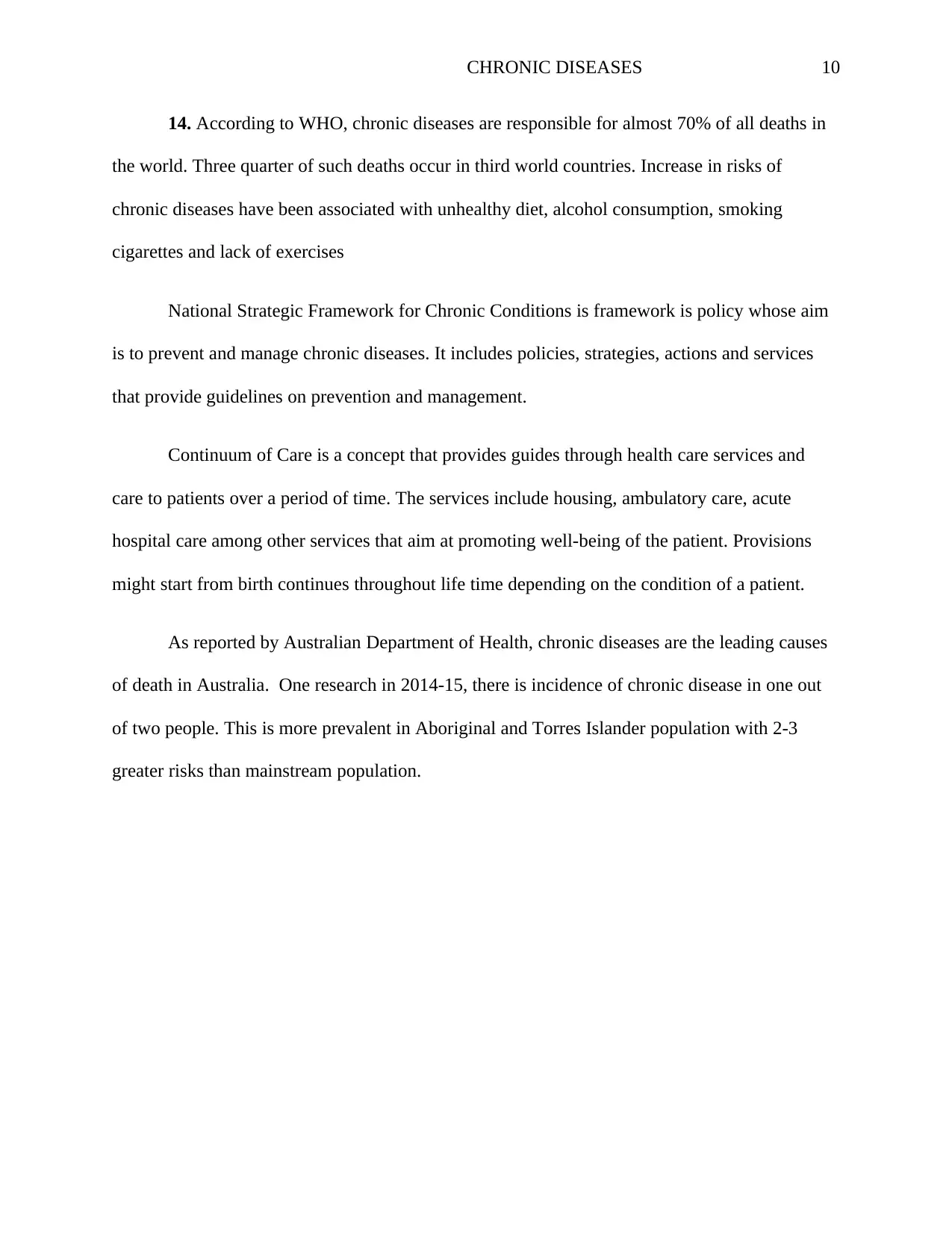
CHRONIC DISEASES 10
14. According to WHO, chronic diseases are responsible for almost 70% of all deaths in
the world. Three quarter of such deaths occur in third world countries. Increase in risks of
chronic diseases have been associated with unhealthy diet, alcohol consumption, smoking
cigarettes and lack of exercises
National Strategic Framework for Chronic Conditions is framework is policy whose aim
is to prevent and manage chronic diseases. It includes policies, strategies, actions and services
that provide guidelines on prevention and management.
Continuum of Care is a concept that provides guides through health care services and
care to patients over a period of time. The services include housing, ambulatory care, acute
hospital care among other services that aim at promoting well-being of the patient. Provisions
might start from birth continues throughout life time depending on the condition of a patient.
As reported by Australian Department of Health, chronic diseases are the leading causes
of death in Australia. One research in 2014-15, there is incidence of chronic disease in one out
of two people. This is more prevalent in Aboriginal and Torres Islander population with 2-3
greater risks than mainstream population.
14. According to WHO, chronic diseases are responsible for almost 70% of all deaths in
the world. Three quarter of such deaths occur in third world countries. Increase in risks of
chronic diseases have been associated with unhealthy diet, alcohol consumption, smoking
cigarettes and lack of exercises
National Strategic Framework for Chronic Conditions is framework is policy whose aim
is to prevent and manage chronic diseases. It includes policies, strategies, actions and services
that provide guidelines on prevention and management.
Continuum of Care is a concept that provides guides through health care services and
care to patients over a period of time. The services include housing, ambulatory care, acute
hospital care among other services that aim at promoting well-being of the patient. Provisions
might start from birth continues throughout life time depending on the condition of a patient.
As reported by Australian Department of Health, chronic diseases are the leading causes
of death in Australia. One research in 2014-15, there is incidence of chronic disease in one out
of two people. This is more prevalent in Aboriginal and Torres Islander population with 2-3
greater risks than mainstream population.
Paraphrase This Document
Need a fresh take? Get an instant paraphrase of this document with our AI Paraphraser
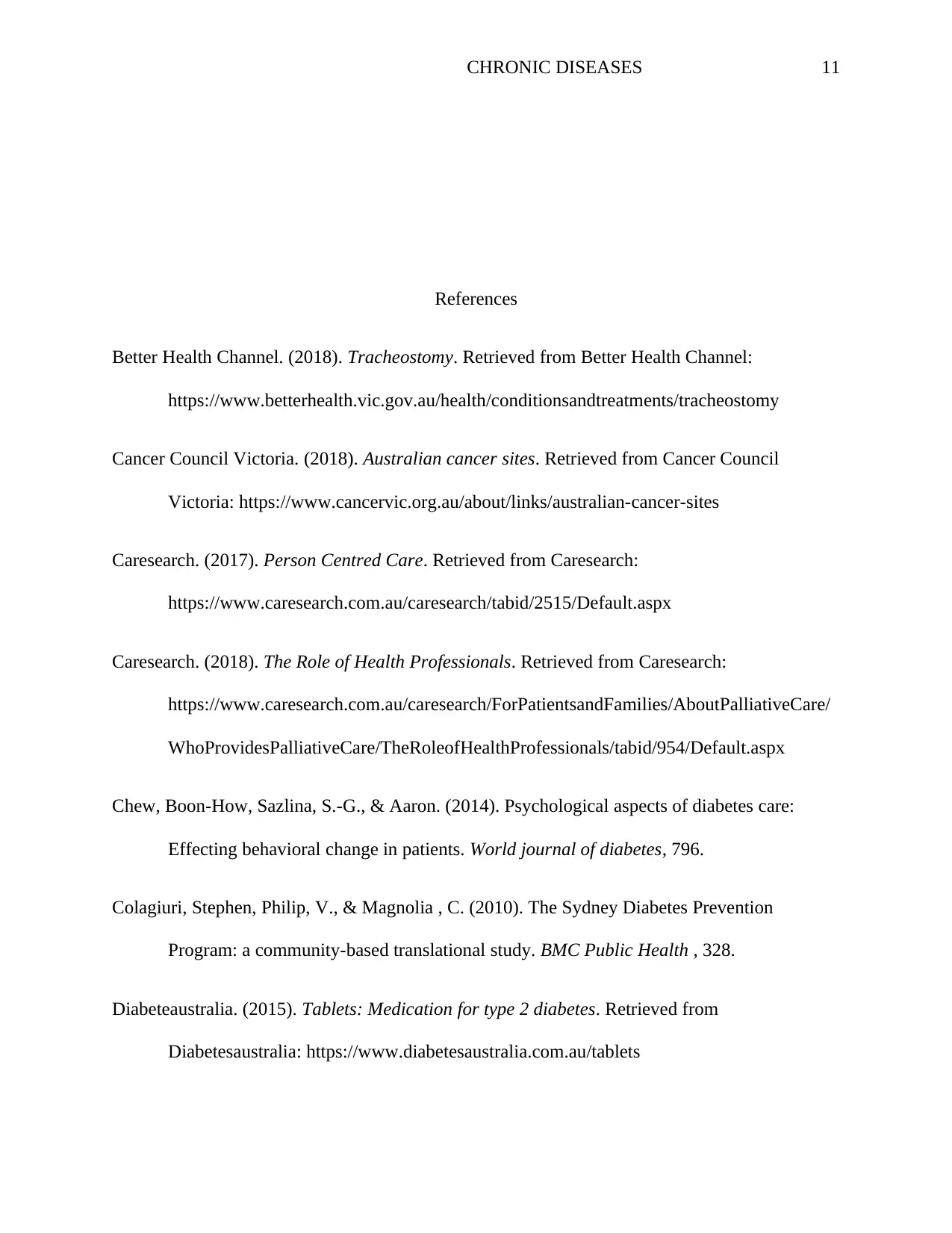
CHRONIC DISEASES 11
References
Better Health Channel. (2018). Tracheostomy. Retrieved from Better Health Channel:
https://www.betterhealth.vic.gov.au/health/conditionsandtreatments/tracheostomy
Cancer Council Victoria. (2018). Australian cancer sites. Retrieved from Cancer Council
Victoria: https://www.cancervic.org.au/about/links/australian-cancer-sites
Caresearch. (2017). Person Centred Care. Retrieved from Caresearch:
https://www.caresearch.com.au/caresearch/tabid/2515/Default.aspx
Caresearch. (2018). The Role of Health Professionals. Retrieved from Caresearch:
https://www.caresearch.com.au/caresearch/ForPatientsandFamilies/AboutPalliativeCare/
WhoProvidesPalliativeCare/TheRoleofHealthProfessionals/tabid/954/Default.aspx
Chew, Boon-How, Sazlina, S.-G., & Aaron. (2014). Psychological aspects of diabetes care:
Effecting behavioral change in patients. World journal of diabetes, 796.
Colagiuri, Stephen, Philip, V., & Magnolia , C. (2010). The Sydney Diabetes Prevention
Program: a community-based translational study. BMC Public Health , 328.
Diabeteaustralia. (2015). Tablets: Medication for type 2 diabetes. Retrieved from
Diabetesaustralia: https://www.diabetesaustralia.com.au/tablets
References
Better Health Channel. (2018). Tracheostomy. Retrieved from Better Health Channel:
https://www.betterhealth.vic.gov.au/health/conditionsandtreatments/tracheostomy
Cancer Council Victoria. (2018). Australian cancer sites. Retrieved from Cancer Council
Victoria: https://www.cancervic.org.au/about/links/australian-cancer-sites
Caresearch. (2017). Person Centred Care. Retrieved from Caresearch:
https://www.caresearch.com.au/caresearch/tabid/2515/Default.aspx
Caresearch. (2018). The Role of Health Professionals. Retrieved from Caresearch:
https://www.caresearch.com.au/caresearch/ForPatientsandFamilies/AboutPalliativeCare/
WhoProvidesPalliativeCare/TheRoleofHealthProfessionals/tabid/954/Default.aspx
Chew, Boon-How, Sazlina, S.-G., & Aaron. (2014). Psychological aspects of diabetes care:
Effecting behavioral change in patients. World journal of diabetes, 796.
Colagiuri, Stephen, Philip, V., & Magnolia , C. (2010). The Sydney Diabetes Prevention
Program: a community-based translational study. BMC Public Health , 328.
Diabeteaustralia. (2015). Tablets: Medication for type 2 diabetes. Retrieved from
Diabetesaustralia: https://www.diabetesaustralia.com.au/tablets
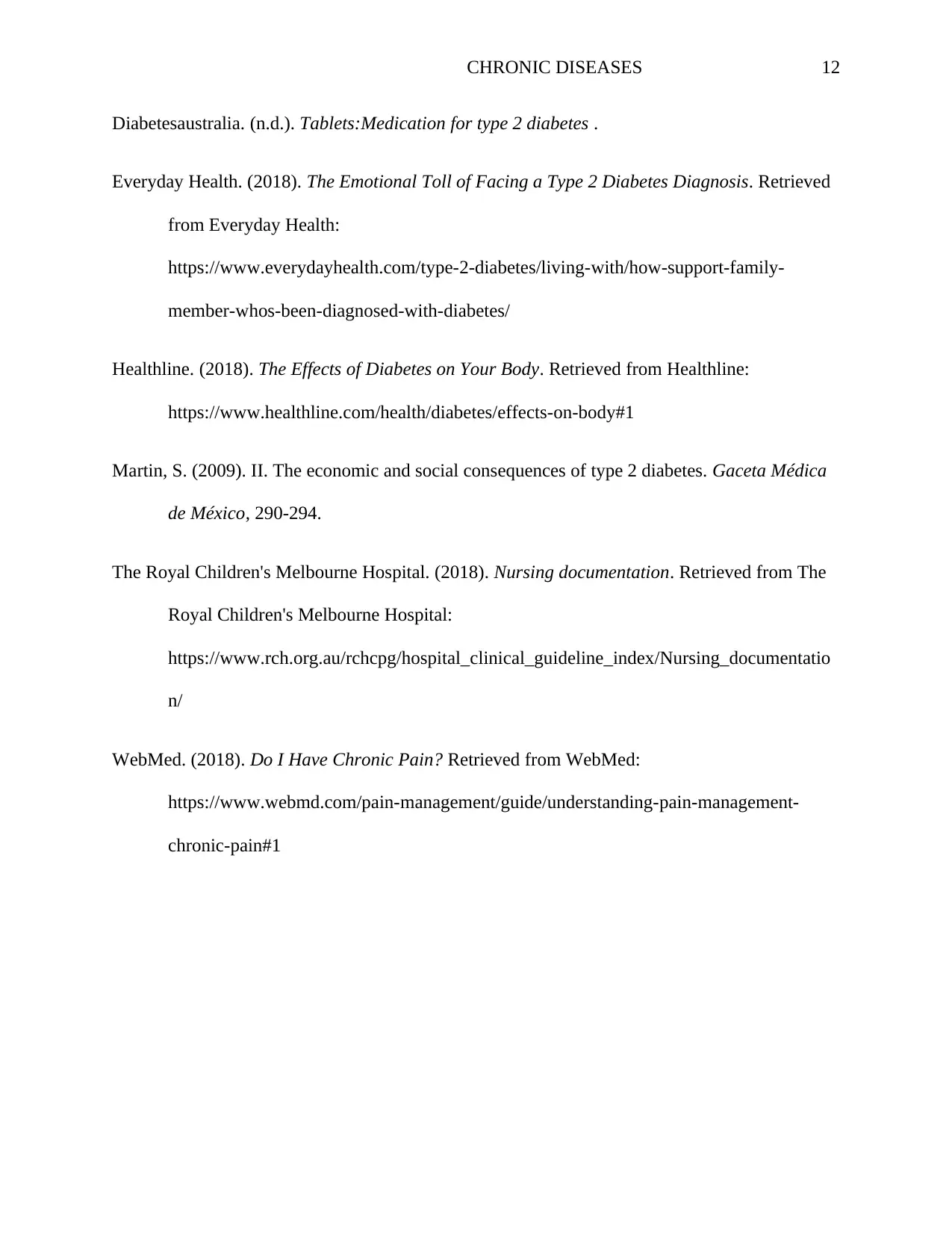
CHRONIC DISEASES 12
Diabetesaustralia. (n.d.). Tablets:Medication for type 2 diabetes .
Everyday Health. (2018). The Emotional Toll of Facing a Type 2 Diabetes Diagnosis. Retrieved
from Everyday Health:
https://www.everydayhealth.com/type-2-diabetes/living-with/how-support-family-
member-whos-been-diagnosed-with-diabetes/
Healthline. (2018). The Effects of Diabetes on Your Body. Retrieved from Healthline:
https://www.healthline.com/health/diabetes/effects-on-body#1
Martin, S. (2009). II. The economic and social consequences of type 2 diabetes. Gaceta Médica
de México, 290-294.
The Royal Children's Melbourne Hospital. (2018). Nursing documentation. Retrieved from The
Royal Children's Melbourne Hospital:
https://www.rch.org.au/rchcpg/hospital_clinical_guideline_index/Nursing_documentatio
n/
WebMed. (2018). Do I Have Chronic Pain? Retrieved from WebMed:
https://www.webmd.com/pain-management/guide/understanding-pain-management-
chronic-pain#1
Diabetesaustralia. (n.d.). Tablets:Medication for type 2 diabetes .
Everyday Health. (2018). The Emotional Toll of Facing a Type 2 Diabetes Diagnosis. Retrieved
from Everyday Health:
https://www.everydayhealth.com/type-2-diabetes/living-with/how-support-family-
member-whos-been-diagnosed-with-diabetes/
Healthline. (2018). The Effects of Diabetes on Your Body. Retrieved from Healthline:
https://www.healthline.com/health/diabetes/effects-on-body#1
Martin, S. (2009). II. The economic and social consequences of type 2 diabetes. Gaceta Médica
de México, 290-294.
The Royal Children's Melbourne Hospital. (2018). Nursing documentation. Retrieved from The
Royal Children's Melbourne Hospital:
https://www.rch.org.au/rchcpg/hospital_clinical_guideline_index/Nursing_documentatio
n/
WebMed. (2018). Do I Have Chronic Pain? Retrieved from WebMed:
https://www.webmd.com/pain-management/guide/understanding-pain-management-
chronic-pain#1
⊘ This is a preview!⊘
Do you want full access?
Subscribe today to unlock all pages.

Trusted by 1+ million students worldwide
1 out of 13
Related Documents
Your All-in-One AI-Powered Toolkit for Academic Success.
+13062052269
info@desklib.com
Available 24*7 on WhatsApp / Email
![[object Object]](/_next/static/media/star-bottom.7253800d.svg)
Unlock your academic potential
Copyright © 2020–2025 A2Z Services. All Rights Reserved. Developed and managed by ZUCOL.




